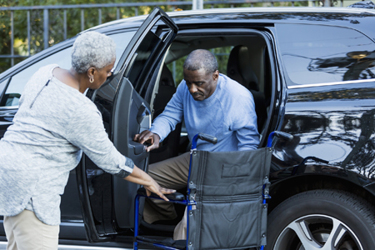Breaking The Socioeconomic Barriers To Clinical Trial Participation
By Candace Saldarini, M.D., senior director, applied innovation process improvement for Otsuka Pharmaceutical Development & Commercialization

Despite efforts to reduce costs associated with clinical trial participation, financial constraints remain an obstacle to enrollment of some patients. One study found that when it comes to cancer clinical trial participation, patients with an annual household income of less than $50,000 had 32% lower odds of participation compared to those with a household income above $50,000.1 Socioeconomic status (SES) encompasses not just income, but also educational attainment, financial security, and subjective perceptions of social status and social class.2
Not surprisingly, SES can influence health.3 For example, the Satcher Health Leadership Institute at Morehouse School of Medicine, with support from Otsuka America Pharmaceutical, Inc., released The Economic Burden of Mental Health Inequities in the United States Report demonstrating how decades of systemic health inequities have yielded significantly worse outcomes for racial and ethnic minoritized, marginalized, and under resourced populations.
Another SES consideration is a potential lack of insurance coverage, which creates barriers to receiving specialty care and can hinder patients’ ability to receive diagnoses or be considered for clinical trials. In 2018, only 86.2% of people in households earning less than $25,000 had insurance coverage, compared to 96.8% in households earning more than $150,000.4
Since low socioeconomic patients are less likely to receive consistent care and therefore may not hear about clinical trials through doctors, it’s important to consider other communication channels such as social media, radio stations, and community facilities such as schools, churches, and free health clinics. Health fairs and advocacy-based events are other opportunities to create awareness for underserved patients.
Even when health insurance is accessible, SES plays a role. According to a recent research study from 3M Health Information Systems, Medicare beneficiaries in low SES areas have fewer physician and care management visits and are less likely to be admitted from the emergency department for low severity medical care or admitted to a skilled nursing or rehabilitation facility following hospital discharge, as compared to Medicare beneficiaries in high SES areas.
According to research from the U.S. Department of Education, only 12 percent of English-speaking adults in the United States have proficient health literacy skills.5 Being more inclusive of varying literacy levels, and languages, in healthcare settings could encourage more opportunities for meaningful information sharing about clinical trial participation.
Recognizing Financial Hardships
When patients with low SES are presented with the opportunity to participate in a clinical trial, they have to consider if the funds provided for their participation are an adequate alternative to work compensation. It’s critical to be very clear on all considerations, including:
- Time off from work: Participants are required to make scheduled visits and could require additional time off from work if an adverse event occurs.
- Childcare: Even if time off from work isn’t a challenge, finding someone to care for young children or other family members during scheduled visits may not be easy or budget friendly.
- Medication: The cost of medication, along with copays for doctor visits, need to be considered if an adverse event were to occur.
- Transportation: Regardless of whether the patient has the ability to drive to the site, as well as any related appointments, gas mileage and related travel costs add up. Lodging may also be a factor for those visiting site locations far from home.
Further underscoring the importance of transparency, one study found 48% of cancer patients who participated in clinical trials had monthly out-of-pocket costs of at least $1,000. The financial burden was worse for those who had a yearly income of less than $60,000 or lived more than 100 miles from the site. Non-white and Hispanic patients, along with patients who were unemployed, were more likely to report high unanticipated costs.6
Expanding Coverage
Earlier this year, promising measures were taken to expand clinical trial coverage for Medicaid patients. Effective Jan. 1, 2022, all state Medicaid programs are required to cover “routine patient costs” for items and services furnished in connection with participating in a qualifying clinical trial. The Consolidated Appropriations Act of 2021, signed into law in December 2020, requires state Medicaid programs to offer the same coverage of routine costs as Medicare, which has covered routine costs of clinical trials since 2000 and commercial insurance since 2014.
“Routine patient costs” includes the coverage of any item or service provided during the clinical trial, including items or services designed to prevent, diagnose, monitor, or treat complications resulting from the participation in the trial to the extent those items or services would otherwise be covered under the state plan outside of a trial.
A “qualifying clinical trial” is defined as clinical trial “conducted in relation to the prevention, detection, or treatment of any serious or life-threatening disease or condition.” The trial must be approved or funded by specific federal agencies or groups listed in the statute, such as NIH, Centers for Disease Control and Prevention (CDC), or other governmental or non-governmental entities.
While it is too early to tell, the changes to Medicare and Medicaid coverage of routine patient costs could incline patients to feel more ready and able to participate in clinical trials. But for that to happen, there needs to be increased patient awareness and education.
Mobilizing Change
Understanding the intricate socioeconomic barriers that can prevent clinical trial participation is crucial as the industry continues to collectively work toward stronger inclusivity. Here are some considerations:
- Be transparent. Uninsured patients should thoroughly understand — prior to clinical trial enrollment — the potential lack of future medication coverage. It’s important to provide detailed information about existing patient assistance programs that may be able to help.
- Prioritize transportation reimbursement. Discuss increasing budgets and reimbursement arrangements with your institutional review board (IRB) chair to help increase access for potential patients.
- Implement flexible hours. With visit times available before or after typical work hours, during lunch, or on the weekends, participants are less likely to need to take time off of work.
- Make childcare available. Offering childcare at the site and/or ensuring reimbursement covers the cost of childcare during the time of the visit, and the time needed to travel to and from the visit, can help reduce the financial burden of some participants.
- Stay informed. Be knowledgeable about state-specific Medicaid Expansion plans, communicate this to patients, and provide any necessary support needed to ensure their coverage could help increase participation.
Mobilizing changes that alleviate some of those barriers will ultimately help increase representation of low-income and minority patients in clinical trials.
References:
- Unger JM, Gralow JR, Albain KS, Ramsey SD, Hershman DL. Patient Income Level and Cancer Clinical Trial Participation: A Prospective Survey Study. JAMA Oncol. 2016 Jan;2(1):137–9.
- Work, Stress and Health & Socioeconomic Status (apa.org)
- The vexing relationship between socioeconomic status and health | Israel Journal of Health Policy Research | Full Text (biomedcentral.com)
- Price K, N, Lyons A, B, Hamzavi I, H, Hsiao J, L, Shi V, Y: Facilitating Clinical Trials Participation of Low Socioeconomic Status Patients. Dermatology 2021; 237:843-846. doi: 10.1159/000511889
- National Action Plan to Improve Health Literacy
- Huey RW, George GC, Phillips P, White R, Fu S, Janku F, Karp DD, Naing A, Piha-Paul S, Subbiah V, Tsimberidou AM, Pant S, Yap TA, Rodon J, MericBernstam F, Shih YT, Hong DS. Patient-Reported Out-of-Pocket Costs and Financial Toxicity During Early-Phase Oncology Clinical Trials. Oncologist. 2021 Jul;26(7):588-596. doi: 10.1002/onco.13767. Epub 2021 Apr 21. PMID: 33783054; PMCID: PMC8265355.
About The Author:
 Candace Saldarini, M.D., is senior director, applied innovation process improvement for Otsuka Pharmaceutical Development & Commercialization. Her focus is to deliver impactful advances in the science and operation of clinical research and development, which will ultimately lead to better care for patients in need. She holds a B.S. from Stanford University and an M.D. from St. George’s University School of Medicine. She completed adult psychiatry training at Yale University and obtained her child and adolescent psychiatry fellowship training at the University of California, Los Angeles.
Candace Saldarini, M.D., is senior director, applied innovation process improvement for Otsuka Pharmaceutical Development & Commercialization. Her focus is to deliver impactful advances in the science and operation of clinical research and development, which will ultimately lead to better care for patients in need. She holds a B.S. from Stanford University and an M.D. from St. George’s University School of Medicine. She completed adult psychiatry training at Yale University and obtained her child and adolescent psychiatry fellowship training at the University of California, Los Angeles.
